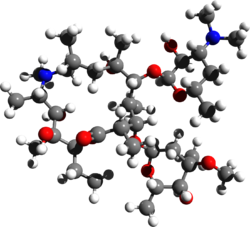 | |
 | |
| Clinical data | |
|---|---|
| Trade names | Sumamed, Hemomicin, Zithromax, others [1] |
| Other names | 9-deoxy-9α-aza-9α-methyl-9α-homoerythromycin A |
| AHFS/Drugs.com | Monograph |
| MedlinePlus | a697037 |
| License data |
|
| Pregnancy category |
|
| Routes of administration | By mouth, intravenous, eye drops |
| Drug class | Macrolide antibiotic |
| ATC code | |
| Legal status | |
| Legal status | |
| Pharmacokinetic data | |
| Bioavailability | 38% for 250 mg capsules |
| Metabolism | Liver |
| Elimination half-life | 68 h |
| Excretion | Bile duct [7] |
| Identifiers | |
| |
| CAS Number | |
| PubChem CID | |
| IUPHAR/BPS | |
| DrugBank | |
| ChemSpider | |
| UNII | |
| KEGG | |
| ChEBI | |
| ChEMBL | |
| NIAID ChemDB | |
| CompTox Dashboard (EPA) | |
| ECHA InfoCard | 100.126.551 |
| Chemical and physical data | |
| Formula | C38H72N2O12 |
| Molar mass | 748.996 g·mol−1 |
| 3D model (JSmol) | |
| |
| |
| (verify) | |

Azithromycin, sold under the brand names Zithromax (in oral form) and Azasite (as an eye drop), is an antibiotic medication used for the treatment of several bacterial infections. [9] This includes middle ear infections, strep throat, pneumonia, traveler's diarrhea, STI and certain other intestinal infections. [9] Along with other medications, it may also be used for malaria. [9] It is administered by mouth, into a vein, or into the eye. [9]
Contents
- Medical uses
- Bacterial susceptibility
- Pregnancy and breastfeeding
- Airway diseases
- Adverse effects
- Interactions
- Colchicine
- Drugs metabolized by CYP3A4
- Pharmacology
- Mechanism of action
- Pharmacokinetics
- History
- Society and culture
- Available forms
- Usage
- Brand names
- Research
- References
- External links
Common side effects include nausea, vomiting, diarrhea and upset stomach. [9] An allergic reaction, such as anaphylaxis, or a type of diarrhea caused by Clostridioides difficile is possible. [9] Azithromycin causes QT prolongation that may cause life-threatening arrhythmias such as torsades de pointes. [10] While some studies claim that no harm has been found with use during pregnancy, [9] more recent studies with mice during late pregnancy has shown adverse effects on embryonic testicular and neural development of prenatal azithromycin exposure (PAzE). However, there need to be more well-controlled studies in pregnant women. [7] Its safety during breastfeeding is not confirmed, but it is likely safe. [11] Azithromycin is an azalide, a type of macrolide antibiotic. [9] It works by decreasing the production of protein, thereby stopping bacterial growth. [9] [12]
Azithromycin was discovered in Croatia in 1980 by the pharmaceutical company Pliva and approved for medical use in 1988. [13] [14] It is on the World Health Organization's List of Essential Medicines. [15] The World Health Organization lists it as an example under "Macrolides and ketolides" in its Critically Important Antimicrobials for Human Medicine (designed to help manage antimicrobial resistance). [16] It is available as a generic medication [17] and is sold under many brand names worldwide. [1] In 2023, it was the 64th most commonly prescribed medication in the United States, with more than 10 million prescriptions. [18] [19]
